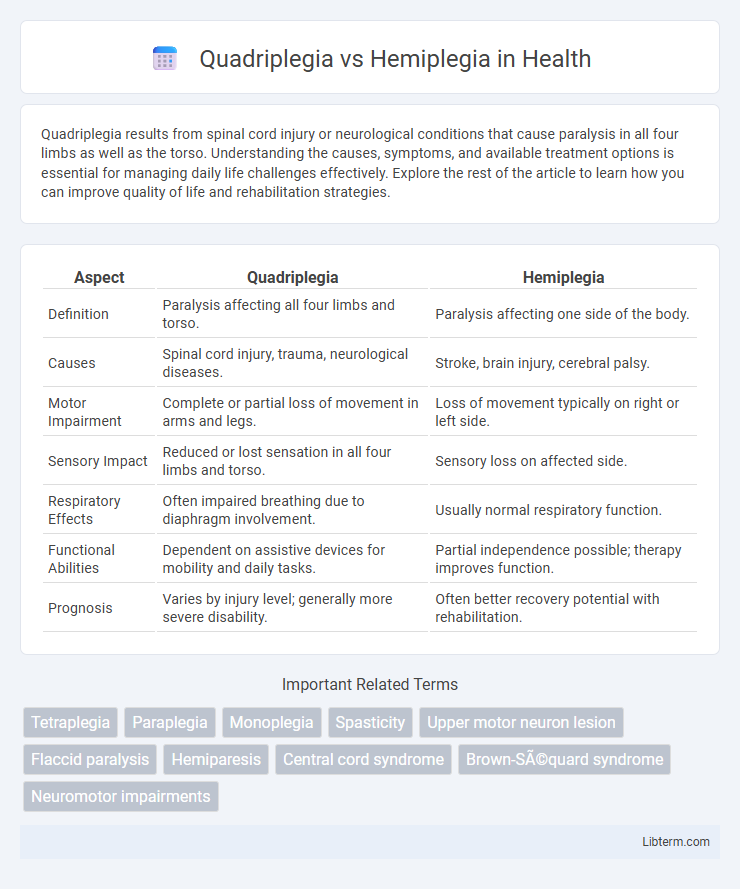Quadriplegia results from spinal cord injury or neurological conditions that cause paralysis in all four limbs as well as the torso. Understanding the causes, symptoms, and available treatment options is essential for managing daily life challenges effectively. Explore the rest of the article to learn how you can improve quality of life and rehabilitation strategies.
Table of Comparison
| Aspect | Quadriplegia | Hemiplegia |
|---|---|---|
| Definition | Paralysis affecting all four limbs and torso. | Paralysis affecting one side of the body. |
| Causes | Spinal cord injury, trauma, neurological diseases. | Stroke, brain injury, cerebral palsy. |
| Motor Impairment | Complete or partial loss of movement in arms and legs. | Loss of movement typically on right or left side. |
| Sensory Impact | Reduced or lost sensation in all four limbs and torso. | Sensory loss on affected side. |
| Respiratory Effects | Often impaired breathing due to diaphragm involvement. | Usually normal respiratory function. |
| Functional Abilities | Dependent on assistive devices for mobility and daily tasks. | Partial independence possible; therapy improves function. |
| Prognosis | Varies by injury level; generally more severe disability. | Often better recovery potential with rehabilitation. |
Understanding Quadriplegia and Hemiplegia
Quadriplegia is characterized by paralysis affecting all four limbs and the torso, usually resulting from spinal cord injuries at the cervical level. Hemiplegia involves paralysis on one side of the body, commonly caused by stroke or brain injury affecting one hemisphere. Understanding these conditions aids in targeted rehabilitation strategies and improved patient outcomes.
Causes of Quadriplegia vs Hemiplegia
Quadriplegia typically results from severe spinal cord injuries affecting the cervical region, leading to paralysis in all four limbs and torso, often caused by trauma such as car accidents or sports injuries. Hemiplegia usually stems from brain damage, such as a stroke or traumatic brain injury, affecting one hemisphere and causing paralysis on the opposite side of the body. Understanding the distinct neurological origins--spinal cord damage for quadriplegia and brain lesions for hemiplegia--is crucial for accurate diagnosis and treatment planning.
Key Differences in Symptoms
Quadriplegia involves paralysis of all four limbs and typically affects both the arms and legs, often accompanied by impaired respiratory function due to cervical spinal cord injury. Hemiplegia results in paralysis on one side of the body, frequently caused by stroke or brain injury, and is characterized by weakness or complete loss of motor function on the affected side, including the arm and leg. Sensory deficits and muscle tone abnormalities vary in severity between the two, with quadriplegia presenting more extensive impairment compared to the unilateral symptoms seen in hemiplegia.
Diagnosis and Medical Evaluation
Diagnosis of quadriplegia involves comprehensive neurological assessments to determine paralysis in all four limbs, often using MRI or CT scans to identify spinal cord injuries at the cervical level. Hemiplegia diagnosis requires targeted neurological exams and imaging studies to detect brain lesions, commonly in the cerebral hemisphere, affecting one side of the body. Electromyography (EMG) and nerve conduction studies further assist in differentiating between central and peripheral causes in both conditions.
Common Treatment Options
Quadriplegia and hemiplegia share common treatment options such as physical therapy, occupational therapy, and medication to manage muscle spasticity and improve motor function. Assistive devices, including wheelchairs for quadriplegia and braces for hemiplegia, support mobility and daily activities. Innovative therapies like functional electrical stimulation and neurorehabilitation techniques are increasingly used to enhance recovery outcomes in both conditions.
Rehabilitation and Therapy Approaches
Quadriplegia rehabilitation emphasizes comprehensive therapy targeting all four limbs, incorporating physical therapy, occupational therapy, and assistive devices to enhance mobility and daily function. Hemiplegia therapy focuses on restoring strength and coordination to one side of the body through constraint-induced movement therapy, neuroplasticity exercises, and repetitive task training. Both conditions benefit from multidisciplinary approaches that include speech therapy, psychological support, and adaptive technologies tailored to patient-specific impairments.
Impact on Daily Life and Activities
Quadriplegia results in paralysis of all four limbs, significantly limiting mobility, self-care, and the ability to perform routine activities without assistance. Hemiplegia affects one side of the body, often allowing partial independence, but challenges remain in balance, coordination, and dexterity, impacting tasks like dressing, eating, and driving. Both conditions necessitate tailored rehabilitation and adaptive tools to maximize functional independence and improve quality of life.
Prognosis and Long-Term Outcomes
Quadriplegia typically results in paralysis of all four limbs, often caused by cervical spinal cord injury, leading to significant long-term disability and dependence on comprehensive care. Hemiplegia affects only one side of the body, commonly due to stroke or brain injury, and may allow for partial recovery with rehabilitation focused on motor function, speech, and sensory integration. Prognosis varies widely, with quadriplegia generally associated with more severe functional limitations and lower life expectancy, while hemiplegia patients have higher potential for functional improvement and independence through individualized therapy.
Support Systems and Resources
Support systems for quadriplegia typically involve comprehensive interdisciplinary teams including physical therapists, occupational therapists, and specialized caregivers to manage extensive mobility and daily living challenges. Hemiplegia support often includes targeted rehabilitation focused on improving strength and coordination on one side of the body, with resources such as speech therapy and community support groups playing a key role. Both conditions benefit from adaptive technologies, accessible housing modifications, and counseling services tailored to enhance independence and quality of life.
Advances in Research and Innovation
Recent advances in neurorehabilitation have enhanced recovery options for quadriplegia and hemiplegia through innovative technologies like brain-computer interfaces and targeted stem cell therapies. Precision medicine approaches enable tailored treatments by leveraging genetic and biomarker data to promote neuroplasticity and functional restoration. Enhanced imaging techniques, including fMRI and DTI, provide critical insights into neural pathway disruptions, supporting improved prognosis and personalized rehabilitation strategies.
Quadriplegia Infographic

 libterm.com
libterm.com